Quantifying the Impacts of Land Use and Cover Change (LUCC) and Climate Change on Discharge and Sediment Load in the Hunhe River Basin, Liaoning Province, Northeast China
Abstract
:1. Introduction
2. Materials and Methods
2.1. Study Area
2.2. Data Collection
2.3. Methodology
2.3.1. SWAT Model Description
2.3.2. SWAT Model Setup
2.3.3. Scenario Settings
2.3.4. Trend Analysis
3. Results
3.1. Change Trends of LUCC, Climate, and Hydrological Variables
3.1.1. Analysis of LUCC
3.1.2. Analysis of Climate Change and Hydrological Variables Change
3.2. Calibration and Validation of SWAT Model
3.3. The Responses of Hydrology to LUCC and Climate Change
3.4. Impacts of Precipitation and Temperature on Hydrology
4. Discussion
4.1. Uncertainty of SWAT Model Simulations
4.2. Contrasting Roles of Climate Change and LUCC on Hydrology
5. Conclusions
- (1)
- During 1980–2009, only minor land use variations were observed (within 1% of the basin area), with a decrease for forestland and an increase for other land use types such as urban land, grassland, and cropland. The precipitation and discharge showed a non-significant monotonic downward trend and sediment load showed a significant monotonic downward trend, with a correspondingly significant monotonic upward trend in temperature.
- (2)
- During the calibration and validation periods, the PBIAS was within ±10% for both discharge and sediment load simulation. Both the NSE and R2 for the monthly discharge ranged from 0.77 to 0.80, indicating a good performance for SWAT model to simulate discharge. The NSE and R2 for the monthly sediment load ranged from 0.65 to 0.78, indicating a satisfactory model performance. The SWAT model proved to be a valid tool for assessing the impacts of climate and land use changes on discharge and sediment load.
- (3)
- During 1980–2009, climate change rather than land use change dominated the hydrological changes in the HRB, and precipitation played a more important role in alterations of discharge and sediment load than temperature.
Author Contributions
Funding
Institutional Review Board Statement
Informed Consent Statement
Data Availability Statement
Acknowledgments
Conflicts of Interest
References
- Lins, H.F.; Slack, J.R. Streamflow trends in the United States. Geophys. Res. Lett. 1999, 26, 227–230. [Google Scholar] [CrossRef] [Green Version]
- Molina-Navarro, E.; Trolle, D.; Martínez-Pérez, S.; Sastre-Merlín, A.; Jeppesen, E. Hydrological and water quality impact assessment of a Mediterranean limno-reservoir under climate change and land use management scenarios. J. Hydrol. 2014, 509, 354–366. [Google Scholar] [CrossRef]
- Bangash, R.F.; Passuello, A.; Sanchez-Canales, M.; Terrado, M.; López, A.; Elorza, F.J.; Ziv, G.; Acuña, V.; Schuhmacher, M. Ecosystem services in Mediterranean river basin: Climate change impact on water provisioning and erosion control. Sci. Total Environ. 2013, 458–460, 246–255. [Google Scholar] [CrossRef]
- Kim, J.; Choi, J.; Choi, C.; Park, S. Impacts of changes in climate and land use/land cover under IPCC RCP scenarios on streamflow in the Hoeya River Basin, Korea. Sci. Total Environ. 2013, 452–453, 181–195. [Google Scholar] [CrossRef]
- Li, Z.; Fang, H. Impacts of climate change on water erosion: A review. Earth Sci. Rev. 2016, 163, 94–117. [Google Scholar] [CrossRef]
- Yang, X.; Sun, W.; Li, P.; Mu, X.; Gao, P.; Zhao, G. Reduced sediment transport in the Chinese Loess Plateau due to climate change and human activities. Sci. Total Environ. 2018, 642, 591–600. [Google Scholar] [CrossRef] [PubMed]
- Brath, A.; Montanari, A.; Moretti, G. Assessing the effect of flood frequency of land use change via hydrological simulation (with uncertainty). J. Hydrol. 2006, 324, 141–153. [Google Scholar] [CrossRef]
- Schilling, K.E.; Jha, M.K.; Zhang, Y.K.; Gassman, P.W.; Wolter, C.F. Impact of land use and land cover change on the water balance of a large agricultural watershed: Historical effects and future directions. Water Resour. Res. 2008, 44, W00A09. [Google Scholar] [CrossRef]
- Yin, J.; He, F.; Xiong, Y.; Qiu, G. Effects of land use/land cover and climate changes on surface runoff in a semi-humid and semi-arid transition zone in northwest China. Hydrol. Earth Syst. Sci. 2017, 21, 183–196. [Google Scholar] [CrossRef] [Green Version]
- Milly, P.C.D.; Dunne, K.A.; Vecchia, A.V. Global pattern of trends in streamflow and water availability in a changing climate. Nature 2005, 438, 347–350. [Google Scholar] [CrossRef]
- Piao, S.; Ciais, P.; Huang, Y.; Shen, Z.; Peng, S.; Li, J.; Zhou, L.; Liu, H.; Ma, Y.; Ding, Y.; et al. The impacts of climate change on water resources and agriculture in China. Nature 2010, 467, 43–51. [Google Scholar] [CrossRef]
- Tu, T.; Ercan, A.; Carr, K.J.; Kavvas, M.L.; Trinh, T.; Ishida, K.; Nosacka, J.; Brown, K. Coupling hydroclimate-hydraulic-sedimentation models to estimate flood inundation and sediment transport during extreme flood events under a changing climate. Sci. Total Environ. 2020, 740, 140117. [Google Scholar] [CrossRef]
- Song, X.; Hansen, M.C.; Stehman, S.V.; Potapov, P.V.; Tyukavina, A.; Vermote, E.F.; Townshend, J.R. Global land change from 1982 to 2016. Nature 2018, 560, 639–64310. [Google Scholar] [CrossRef]
- Xie, Z.; Mu, X.; Gao, P.; Wu, C.; Qiu, D. Impacts of Climate and Anthropogenic Activities on Streamflow Regimes in the Beiluo River, China. Water 2021, 13, 2892. [Google Scholar] [CrossRef]
- Kundu, S.; Khare, D.; Mondal, A. Individual and combined impacts of future climate and land use changes on the water balance. Ecol. Eng. 2017, 105, 42–57. [Google Scholar] [CrossRef]
- Wang, G.; Zhang, J.; Yang, Q. Attribution of Runoff Change for the Xinshui River Catchment on the Loess Plateau of China in a Changing Environment. Water 2016, 8, 267. [Google Scholar] [CrossRef] [Green Version]
- Zhou, Y.; Lai, C.; Wang, Z.; Chen, X.; Zeng, Z.; Chen, J.; Bai, X. Quantitative Evaluation of the Impact of Climate Change and Human Activity on Runoff Change in the Dongjiang River Basin, China. Water 2018, 10, 571. [Google Scholar] [CrossRef] [Green Version]
- Stagl, J.C.; Hattermann, F.F. Impacts of Climate Change on the Hydrological Regime of the Danube River and Its Tributaries Using an Ensemble of Climate Scenarios. Water 2015, 7, 6139–6172. [Google Scholar] [CrossRef]
- Chawla, I.; Mujumdar, P.P. Isolating the impacts of land use and climate change on streamflow. Hydrol. Earth Syst. Sci. 2015, 19, 3633–3651. [Google Scholar] [CrossRef] [Green Version]
- Napoli, M.; Massetti, L.; Orlandini, S. Hydrological response to land use and climate changes in a rural hilly basin in Italy. Catena 2017, 157, 1–11. [Google Scholar] [CrossRef]
- Luo, K.S.; Tao, F.L.; Moiwo, J.P.; Xiao, D. Attribution of hydrological change in Heihe River Basin to climate and land use change in the past three decades. Sci. Rep. 2016, 6, 33704. [Google Scholar] [CrossRef] [Green Version]
- Li, Z.; Liu, W.; Zhang, X.; Zheng, F. Impacts of land use change and climate variability on hydrology in an agricultural catchment on the Loess Plateau of China. J. Hydrol. 2009, 377, 35–42. [Google Scholar] [CrossRef]
- Akoko, G.; Le, T.U.; Gomi, T.; Kato, T. A Review of SWAT Model Application in Africa. Water 2021, 13, 1313. [Google Scholar] [CrossRef]
- Tan, M.L.; Gassman, P.W.; Srinivasan, R.; Arnold, J.G.; Yang, X. A Review of SWAT Studies in Southeast Asia: Applications, Challenges and Future Directions. Water 2019, 11, 914. [Google Scholar] [CrossRef] [Green Version]
- Zhang, Q.; Gu, X.; Singh, V.P.; Xu, C.; Kong, D.; Xiao, M.; Chen, X. Homogenization of precipitation and flow regimes across China: Changing properties, causes and implications. J. Hydrol. 2015, 530, 462–475. [Google Scholar] [CrossRef]
- Liu, J.; Zhang, Q.; Singh, W.P.; Shi, P. Contribution of multiple climatic variables and human activities to streamflow changes across China. J. Hydrol. 2017, 545, 145–162. [Google Scholar] [CrossRef] [Green Version]
- SRTM Digital Elevation Database. Available online: http://srtm.csi.cgiar.org/ (accessed on 10 March 2021).
- HWSD Data. Available online: http://www.ncdc.ac.cn (accessed on 2 April 2021).
- Land Use Maps. Available online: https://www.resdc.cn/ (accessed on 7 March 2021).
- Observed Meteorological Data. Available online: http://data.cma.cn (accessed on 12 March 2021).
- Arnold, J.G.; Srinivasan, R.; Muttiah, R.S.; Williams, J.R. Large area hydrologic modeling and assessment—Part 1: Model development. J. Am. Water Resour. Assoc. 1998, 34, 73–89. [Google Scholar] [CrossRef]
- Neitsch, S.L.; Arnold, J.G.; Kiniry, J.R.; Williams, J.R. Soil and Water Assessment Tool Theoretical Documentation Version 2009; Texas Water Resources Institute: College Station, TX, USA, 2011. [Google Scholar]
- USDA Soil Conservation Service. National Engineering Handbook Section 4 Hydrology; Department of Agriculture-Soil Conservation Service: Washington, DC, USA, 1972. [Google Scholar]
- Monteith, J.L. Evaporation and the environment in the State and Movement of Water in Living Organisms. In Proceedings of the 19th Symposia of the Society for Experimental Biology, Swansea, UK, September 1964; Cambridge University Press: London, UK, 1965; pp. 205–234. [Google Scholar]
- Abbaspour, K.C.; Johnson, C.A.; Van Genuchten, M.T. Estimating uncertain flow and transport parameters using a sequential uncertainty fitting procedure. Vadose Zone J. 2004, 3, 1340–1352. [Google Scholar] [CrossRef]
- Moriasi, D.N.; Gitau, M.W.; Pai, N.; Daggupati, P. Hydrologic and water quality models: Performance measures and evaluation criteria. Trans. ASABE 2015, 58, 1763–1785. [Google Scholar] [CrossRef] [Green Version]
- Mann, H.B. Nonparametric tests against trend. Econometrica 1945, 13, 245–259. [Google Scholar] [CrossRef]
- Kendall, M.G. Rank Correlation Methods; Charles Griffin and Co. Ltd.: London, UK, 1975; p. 15. [Google Scholar]
- Serrano, V.L.; Mateos, V.L.; Garcia, J.A. Trend analysis of monthly precipitation over the Iberian Peninsula for the period 1921–1995. Phys. Chem. Earth 1999, 24, 85–90. [Google Scholar] [CrossRef]
- Mitchell, J.M.; Dzerdzeevskii, B.; Flohn, H.; Hofmeyr, W.L.; Lamb, H.H.; Rao, K.N.; Wallen, C.C. Climatic change. In WMO Technical Note No.79; World Meteorological Organization: Geneva, Switzerland, 1966. [Google Scholar]
- Guo, Y.; Fang, G.; Xu, Y.; Tian, X.; Xie, J. Identifying how future climate and land use/cover changes impact streamflow in Xinanjiang Basin, East China. Sci. Total Environ. 2020, 710, 13627. [Google Scholar] [CrossRef] [PubMed]
- Li, L.; Jiang, D.; Hou, X.; Li, J. Simulated runoff responses to land use in the middle and upstream reaches of Taoerhe River basin, Northeast China, in wet, average and dry years. Hydrol. Process. 2013, 27, 3484–3494. [Google Scholar] [CrossRef]
- Gocic, M.; Trajkovic, S. Analysis of changes in meteorological variables using Mann-Kendall and Sen’s slope estimator statistical tests in Serbia. Global Planet. Chang. 2013, 100, 172–182. [Google Scholar] [CrossRef]
- Xu, Z.; Pang, J.; Liu, C.; Li, J. Assessment of runoff and sediment yield in the Miyun Reservoir catchment by using SWAT model. Hydrol. Process. 2009, 23, 3619–3630. [Google Scholar] [CrossRef]
- Khoi, D.N.; Suetsugi, T. The responses of hydrological processes and sediment yield to land-use and climate change in the Be River Catchment, Vietnam. Hydrol. Process. 2014, 28, 640–652. [Google Scholar] [CrossRef]
- Yan, B.; Fang, N.; Zhang, P.; Shi, Z. Impacts of land use change on watershed stream flow and sediment yield an assessment using hydrologic modelling and partial least squares regression. J. Hydrol. 2013, 484, 26–37. [Google Scholar] [CrossRef]
- Le, J.; Wang, G. Brief analysis of rainstorm and flood in July 1995 in Hunhe River Basin. J. China Hydrol. 1997, 6, 57–59. (In Chinese) [Google Scholar]
- Wang, D.; Wang, C.; Fu, H.; Liang, G. Analysis of rainstorm flood in August 2005 in Liaohe River Basin. J. China Hydrol. 2006, 26, 76–79. (In Chinese) [Google Scholar]
- Zeng, D.; Zhang, Y. Rainstorm and flood in August 1985 in Liaohe River Basin. J. China Hydrol. 1987, 2, 48–52. (In Chinese) [Google Scholar]
- Wang, S.; Luan, J.; Liu, Q. Analysis of Sediment Characteristics in Upper Hunhe River Basin (Fushun Section). Water Resour. Hydr. Northeast. Chin. 2008, 26, 28–29. (In Chinese) [Google Scholar]
- Liu, W.; Cai, T.; Fu, G.; Zhang, A.; Liu, C.; Yu, H. The streamflow trend in Tangwang River basin in northeast China and its difference response to climate and land use change in sub-basins. Environ. Earth Sci. 2013, 69, 51–62. [Google Scholar] [CrossRef]
- Guo, J. Hydrological Responses to Land Use Change and Climate Variability in Chaohe Watershed, Beijing, China; Beijing Forestry University: Beijing, China, 2012. (In Chinese) [Google Scholar]
- Serpa, D.; Nunes, J.P.; Santos, E.S.; Jacinto, R.; Veiga, S.; Lima, J.C.; Moreira, M.; Corte-Real, J.; Keizer, J.J.; Abrantes, N. Impacts of climate and land use changes on the hydrological and erosion processes of two contrasting Mediterranean catchments. Sci. Total Environ. 2015, 538, 64–77. [Google Scholar] [CrossRef] [PubMed] [Green Version]
- Willuweit, L.; O’Sullivan, J.J.; Shahumyan, H. Simulating the effects of climate change, economic and urban planning scenarios on urban runoff patterns of a metropolitan region. Urban Water J. 2016, 13, 803–818. [Google Scholar] [CrossRef]
- Wong, T.S.W.; Chen, C. Use of a Tropical Basin Model to Assess the Importance of Urbanized Land Condition on the Increase of Flood Peak. Water Sci. Technol. 1994, 29, 155–161. [Google Scholar] [CrossRef]
- Ghaffari, G.; Keesstra, S.; Ghodousi, J.; Ahmadi, H. SWAT-simulated hydrological impact of land-use change in the Zanjanrood basin, Northwest Iran. Hydrol. Process. 2010, 24, 892–903. [Google Scholar] [CrossRef]
- Lin, B.; Chen, X.; Yao, H.; Chen, Y.; Liu, M.; Gao, L.; James, A. Analyses of landuse change impacts on catchment runoff using different time indicators based on SWAT model. Ecol. Indic. 2015, 58, 55–63. [Google Scholar] [CrossRef]
- Zhang, M.; Liu, N.; Harper, R.; Li, Q.; Liu, K.; Wei, X.; Ning, D.; Hou, Y.; Liu, S. A global review on hydrological responses to forest change across multiple spatial scales: Importance of scale, climate, forest type and hydrological regime. J. Hydrol. 2017, 546, 44–59. [Google Scholar] [CrossRef] [Green Version]
- Nunes, J.P.; Naranjo Quintanilla, P.; Santos, J.M.; Serpa, D.; Carvalho-Santos, C.; Rocha, J.; Keizer, J.J.; Keesstra, S.D. Afforestation, subsequent forest fires and provision of hydrological services: A model-based analysis for a Mediterranean mountainous catchment. Land Degrad. Dev. 2018, 29, 776–788. [Google Scholar] [CrossRef]
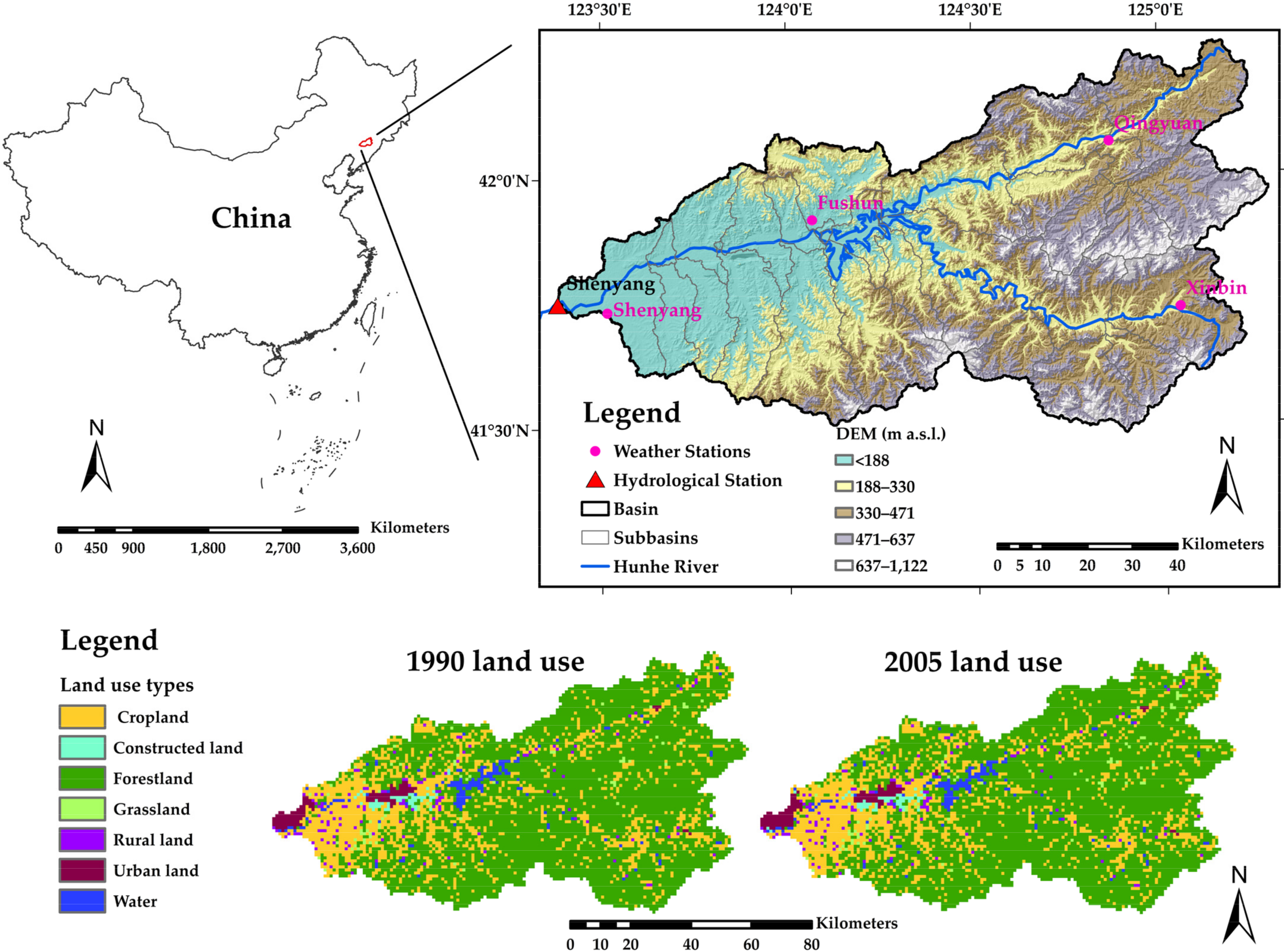
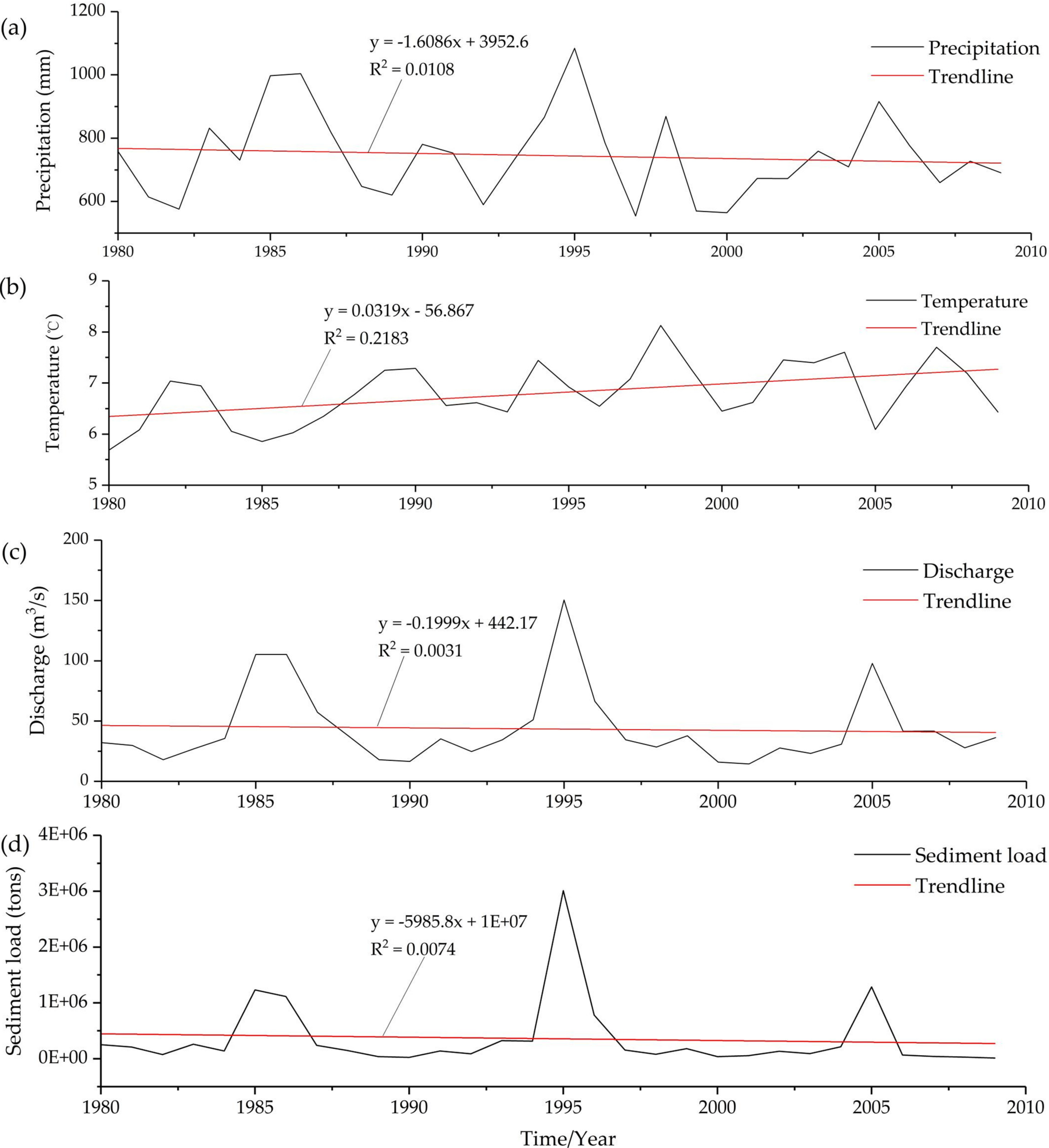
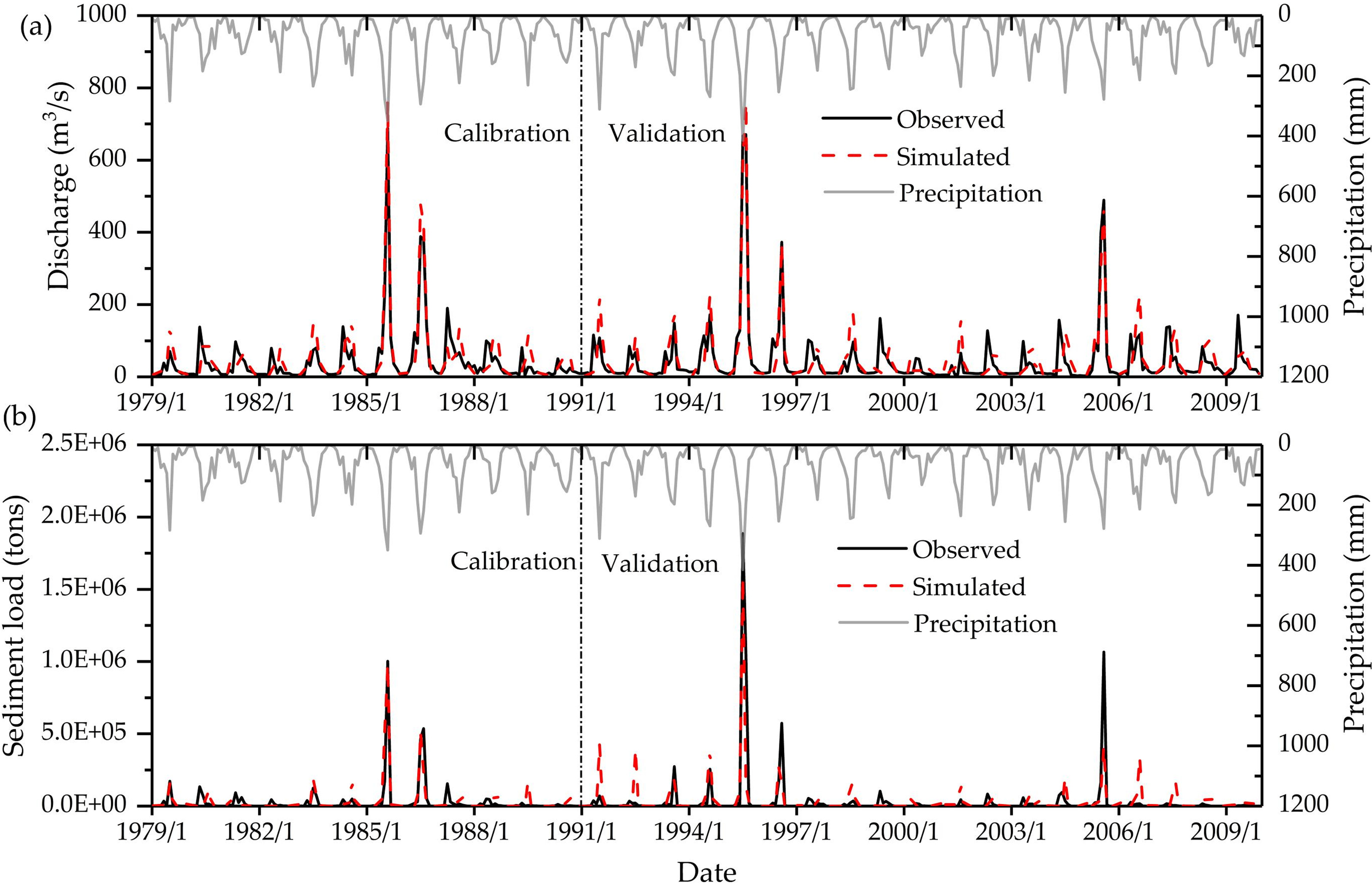
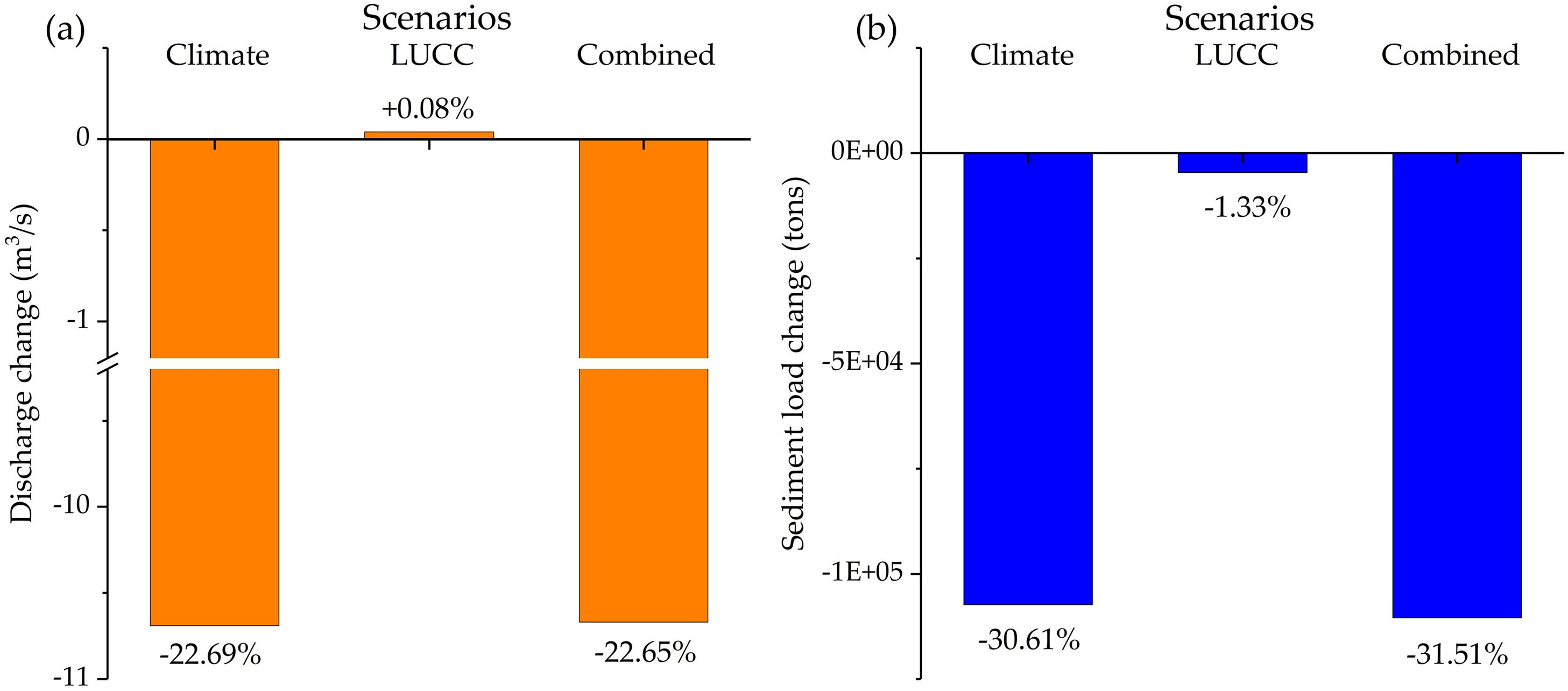
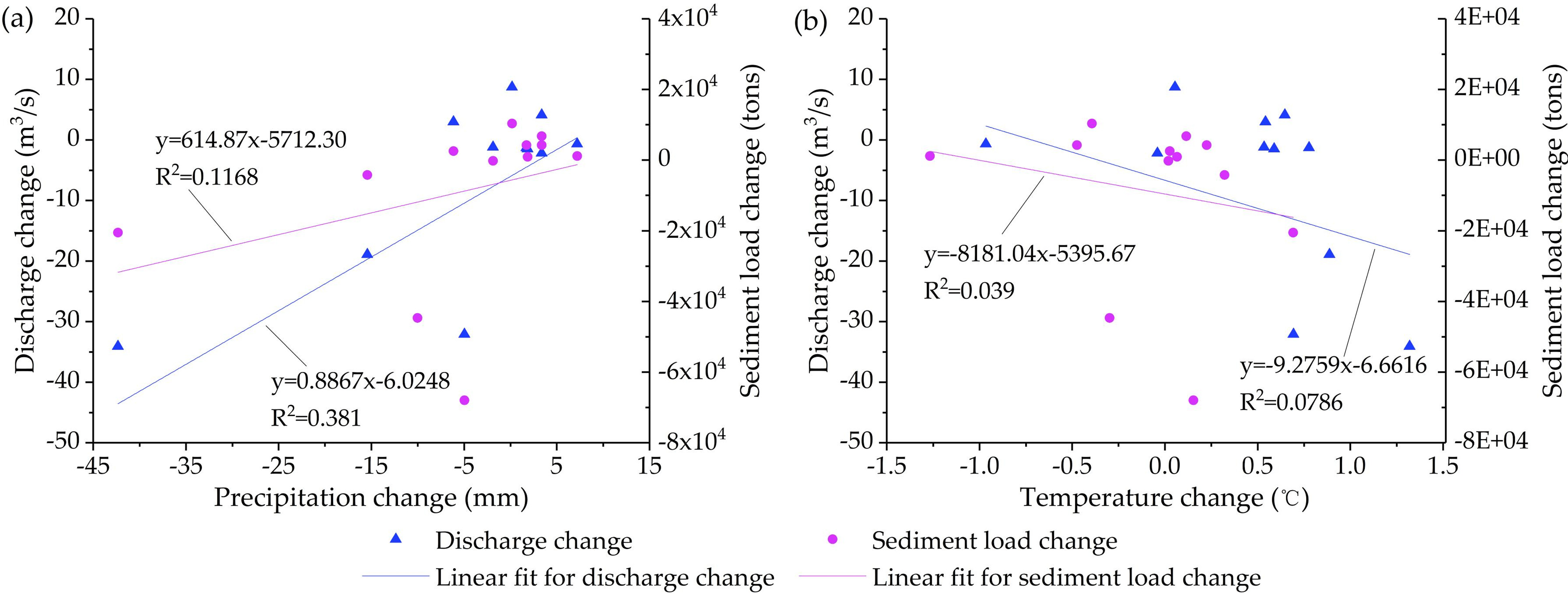
| Elements | Indicators | Very Good | Good | Satisfactory | Unsatisfactory |
|---|---|---|---|---|---|
| Discharge | R2 | R2 > 0.85 | 0.75 < R2 ≤ 0.85 | 0.60 < R2 ≤ 0.75 | R2 ≤ 0.60 |
| NSE | NSE > 0.80 | 0.70 < NSE ≤ 0.80 | 0.50 < NSE ≤ 0.70 | NSE ≤ 0.50 | |
| PBIAS (%) | PBIAS < ±5 | ±5 ≤ PBIAS < ± 10 | ±10 ≤ PBIAS < ± 15 | PBIAS ≥ ±15 | |
| Sediment load | R2 | R2 > 0.80 | 0.65 < R2 ≤ 0.80 | 0.40 < R2 ≤ 0.65 | R2 ≤ 0.40 |
| NSE | NSE > 0.80 | 0.70 < NSE ≤ 0.80 | 0.45 < NSE ≤ 0.70 | NSE ≤ 0.45 | |
| PBIAS (%) | PBIAS < ±10 | ±10 ≤ PBIAS < ±15 | ±15 ≤ PBIAS < ±20 | PBIAS ≥ ±20 |
| Parameter | Definition | Range | Sensitivity Rank | Optimal |
|---|---|---|---|---|
| Parameters used to calibrate discharge | ||||
| v GW_DELAY.gw | Groundwater delay time (day) | 0–500 | 1 | 18.8 |
| v ALPHA_BNK.rte | Baseflow alpha factor for bank storage (day) | 0–1 | 2 | 0.58 |
| r CN2.mgt | SCS runoff curve number for moisture condition II | 35–98 | 3 | 0.21 |
| r SOL_K.sol | Soil conductivity (mm/h) | 0–2000 | 4 | 0.004 |
| v ALPHA_BF.gw | Baseflow alpha factor (day) | 0–1 | 5 | 0.86 |
| v ESCO.hru | Soil evaporation compensation factor | 0.01–1 | 6 | 0.76 |
| Parameters used to calibrate sediment | ||||
| v PRF.bsn | Peak rate adjustment factor for sediment routing in the main channel | 0–2 | 1 | 1.45 |
| v SPCON.bsn | Linear parameters for calculating the channel sediment rooting | 0.001–0.01 | 2 | 0.006 |
| v CH_EROD.rte | Channel erodibility factor | 0–0.6 | 3 | 0.39 |
| v CH_COV.rte | Channel cover factor | 0–1 | 4 | 0.25 |
| v USLE_P.mgt | USLE equation support practices (P) factor | 0–1 | 5 | 0.48 |
| v SPEXP.bsn | Exponent parameter for calculating the channel sediment routing | 1–1.5 | 6 | 1.44 |
| Scenarios | Land Use | Climate | |
|---|---|---|---|
| S1 | Baseline scenario | 1990 | 1980–1990 |
| S2 | Climate change scenario | 1990 | 1999–2009 |
| S3 | LUCC scenario | 2005 | 1980–1990 |
| S4 | Combined scenario | 2005 | 1999–2009 |
| Land Use Type | Year | Area Change (km2) | Area Change of Total Area (%) | |
|---|---|---|---|---|
| 1990 | 2005 | |||
| Cropland | 1884.2 | 1887.1 | 2.9 | 0.04 |
| Forestland | 5483.1 | 5454.3 | −28.8 | −0.36 |
| Grassland | 75.3 | 80.2 | 4.9 | 0.06 |
| Water | 160.5 | 165.4 | 4.9 | 0.06 |
| Urban | 130.8 | 140.7 | 9.9 | 0.13 |
| Rural land | 131.8 | 136.7 | 4.9 | 0.06 |
| Constructed land | 53.5 | 54.5 | 1.0 | 0.01 |
| Stations | Precipitation | Temperature | Discharge | Sediment Load | ||||||||
|---|---|---|---|---|---|---|---|---|---|---|---|---|
| Slope | Z | p | Slope | Z | p | Slope | Z | p | Slope | Z | p | |
| Xinbin | 0.235 | 0 | 0.043 | 2.68 | ** | |||||||
| Qingyuan | −2.313 | −0.93 | 0.049 | 3.00 | ** | |||||||
| Fushun | −0.095 | −0.04 | 0.041 | 2.71 | ** | |||||||
| Shenyang | 0.317 | 0.11 | 0.014 | 1.00 | −0.004 | 0 | −5904.8 | −2.03 | * | |||
| Average | −1.63 | −0.46 | 0.037 | 2.60 | ** | |||||||
| Periods | Evaluation Indicators | Discharge | Sediment Load |
|---|---|---|---|
| Calibration (1979–1990) | NSE | 0.79 | 0.77 |
| R2 | 0.84 | 0.78 | |
| PBIAS (%) | −9.61 | −2.56 | |
| Validation (1991–2009) | NSE | 0.77 | 0.65 |
| R2 | 0.79 | 0.65 | |
| PBIAS (%) | 1.48 | 8.31 |
| Scenarios | Simulated Discharge (m3/s) | Discharge Change (m3/s) | Discharge Change (%) | Simulated Sediment Load (Tons) | Sediment Load Change (Tons) | Sediment Load Change (%) |
|---|---|---|---|---|---|---|
| S1 (baseline) | 47.09 | — | — | 350,611 | — | — |
| S2 (climate) | 36.40 | −10.69 | −22.69 | 243,305 | −107,306 | −30.61 |
| S3 (LUCC) | 47.12 | 0.04 | 0.08 | 345,953 | −4658 | −1.33 |
| S4 (combined) | 36.42 | −10.67 | −22.65 | 240,134 | −110,477 | −31.51 |
Publisher’s Note: MDPI stays neutral with regard to jurisdictional claims in published maps and institutional affiliations. |
© 2022 by the authors. Licensee MDPI, Basel, Switzerland. This article is an open access article distributed under the terms and conditions of the Creative Commons Attribution (CC BY) license (https://creativecommons.org/licenses/by/4.0/).
Share and Cite
Zhang, L.; Jiang, Y.; Yang, M.; Wang, H.; Dong, N.; Wang, H.; Liu, X.; Chen, L.; Liu, K. Quantifying the Impacts of Land Use and Cover Change (LUCC) and Climate Change on Discharge and Sediment Load in the Hunhe River Basin, Liaoning Province, Northeast China. Water 2022, 14, 737. https://doi.org/10.3390/w14050737
Zhang L, Jiang Y, Yang M, Wang H, Dong N, Wang H, Liu X, Chen L, Liu K. Quantifying the Impacts of Land Use and Cover Change (LUCC) and Climate Change on Discharge and Sediment Load in the Hunhe River Basin, Liaoning Province, Northeast China. Water. 2022; 14(5):737. https://doi.org/10.3390/w14050737
Chicago/Turabian StyleZhang, Limin, Yunzhong Jiang, Mingxiang Yang, Hao Wang, Ningpeng Dong, Hejia Wang, Xuan Liu, Liang Chen, and Ke Liu. 2022. "Quantifying the Impacts of Land Use and Cover Change (LUCC) and Climate Change on Discharge and Sediment Load in the Hunhe River Basin, Liaoning Province, Northeast China" Water 14, no. 5: 737. https://doi.org/10.3390/w14050737
APA StyleZhang, L., Jiang, Y., Yang, M., Wang, H., Dong, N., Wang, H., Liu, X., Chen, L., & Liu, K. (2022). Quantifying the Impacts of Land Use and Cover Change (LUCC) and Climate Change on Discharge and Sediment Load in the Hunhe River Basin, Liaoning Province, Northeast China. Water, 14(5), 737. https://doi.org/10.3390/w14050737







